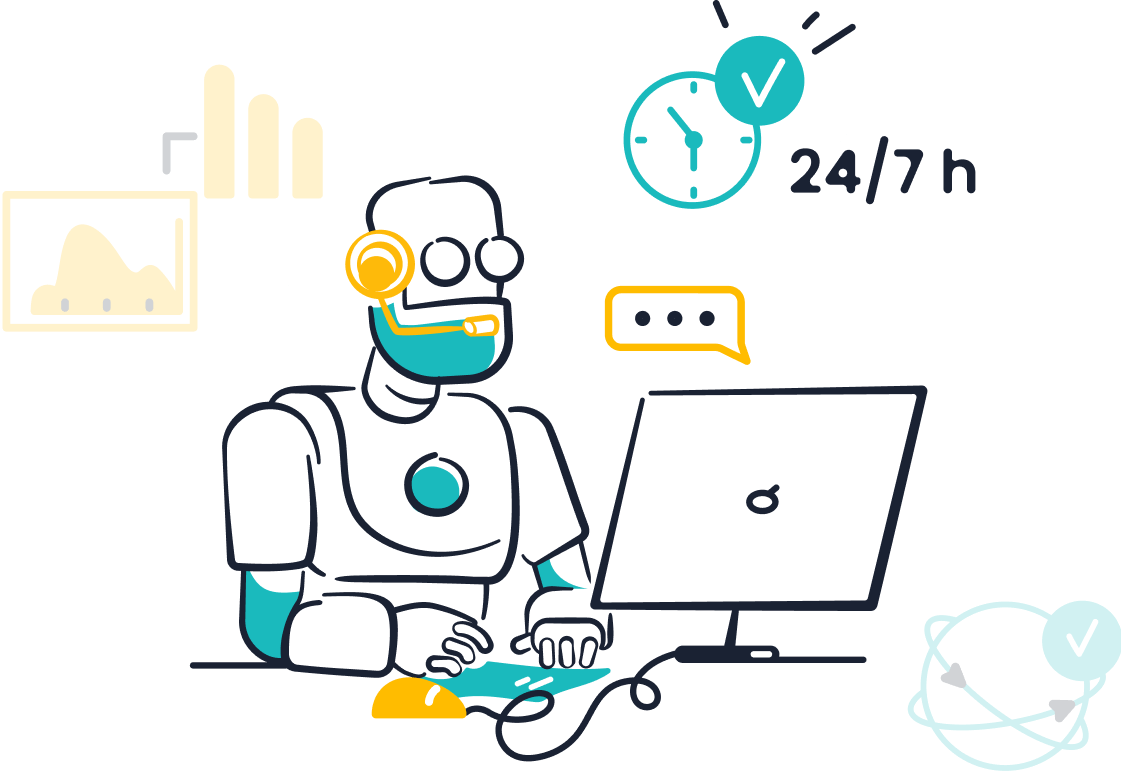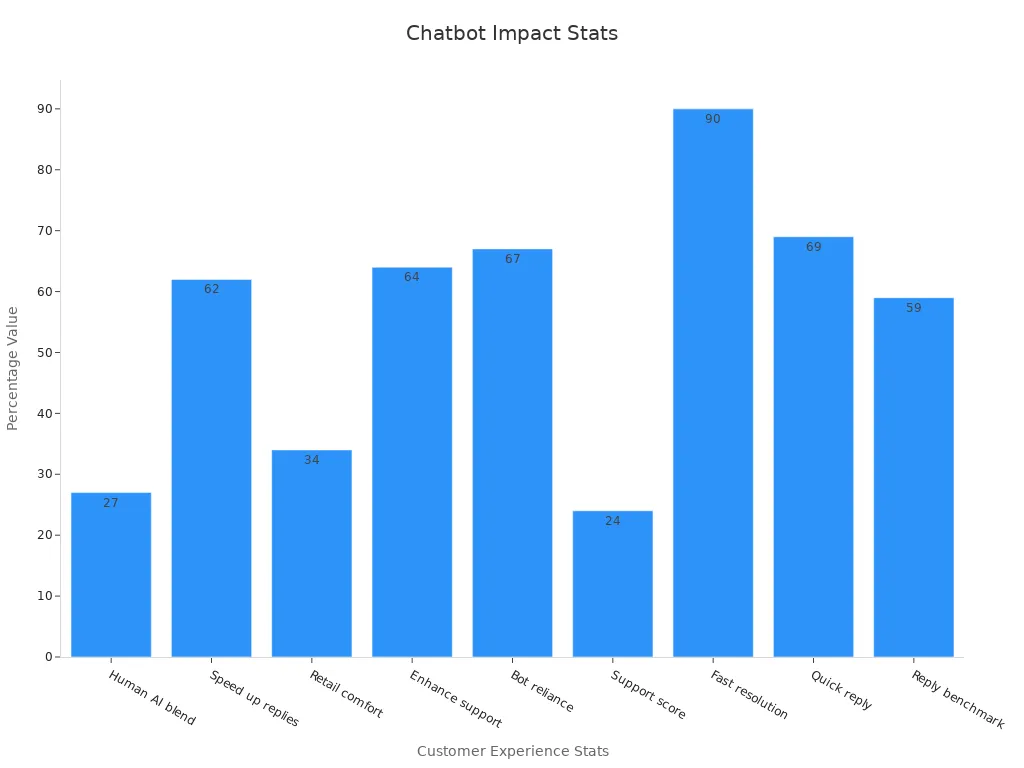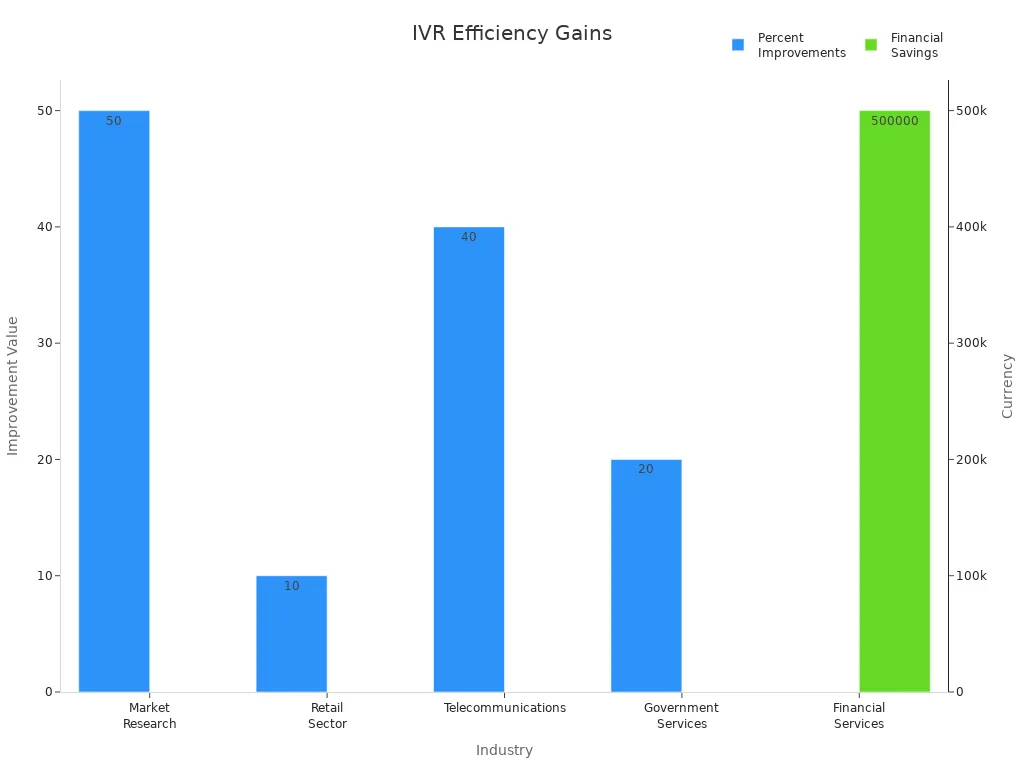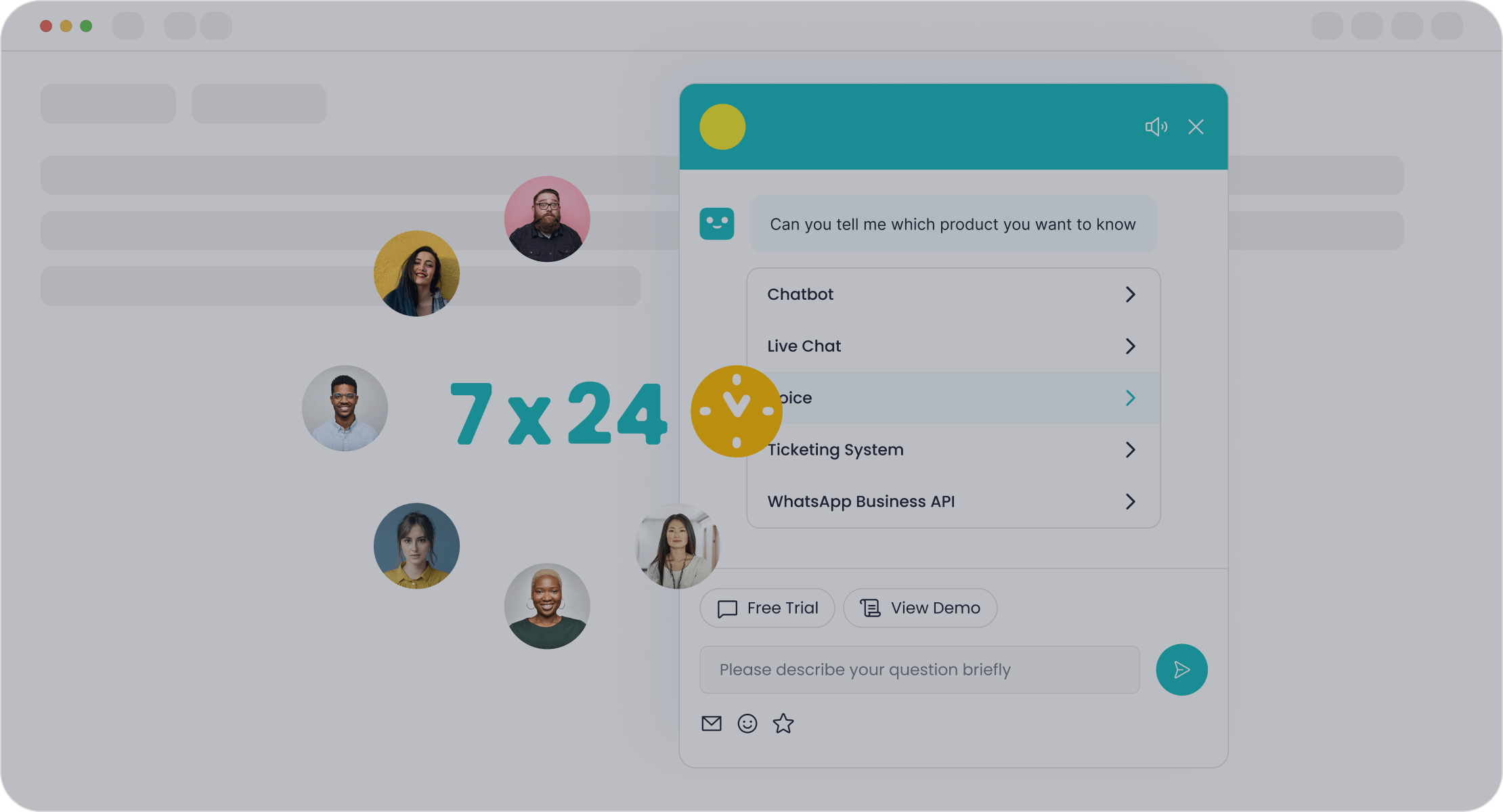Automatic Customer Service Examples That Transform Support

Imagine a world where your customer service operates 24/7, solving queries instantly and saving you money. That’s the transformative power of automatic customer service. Automated customer service is revolutionizing how businesses like yours interact with customers, offering faster responses and better experiences. For instance, companies using AI chatbots have seen customer service costs drop by 30%, while response times have been slashed by 37%. These tools don’t just save money—they also boost satisfaction, with repeat purchases increasing by 36%.
Sobot exemplifies this shift by offering cutting-edge solutions that streamline interactions across channels. From chatbots to predictive analytics, Sobot's automation empowers you to meet customer expectations effortlessly. Whether it’s reducing resolution time by 52% or improving agent productivity, automated systems are redefining what’s possible in customer service.
Chatbots: The Cornerstone of Automated Customer Service

What Are Chatbots and How Do They Work?
Chatbots are interactive bots designed to simulate human conversations. They use advanced technologies like natural language processing (NLP) and machine learning (ML) to understand and respond to customer queries. These bots analyze text, recognize intent, and generate replies that feel natural and relevant. For example, NLP enables chatbots to process language nuances, while ML helps them improve responses over time by learning from past interactions.
Here’s how chatbots operate:
- Text Preprocessing: They clean and structure raw text for analysis.
- Intent Recognition: They identify what customers want based on their input.
- Response Generation: They craft replies tailored to the context of the conversation.
By managing dialog flow and tracking user inputs, chatbots ensure smooth and coherent interactions. This makes them a vital tool in automated customer service environments.
Benefits of Chatbots for Customer Experience
Chatbots bring a host of benefits to customer interactions. They’re available 24/7, ensuring customers always get support when they need it. Their multilingual capabilities allow businesses to connect with a global audience, breaking language barriers. Personalization is another key feature—chatbots use customer data to deliver tailored responses, fostering loyalty and satisfaction.
Here’s a quick overview of their features:
| Feature | Description |
|---|---|
| 24/7 Availability | Accessible anytime, enhancing trust and satisfaction. |
| Multilingual Support | Communicates effectively across languages, improving global customer experience. |
| Personalization | Creates customized interactions based on customer data. |
| Sentiment Analysis | Adjusts responses based on emotions, improving empathy. |
| Lead Generation | Collects data to qualify leads, streamlining sales. |
| Omnichannel Support | Ensures consistent service across platforms, boosting engagement. |
| Escalation to Human Agents | Transfers complex cases to live agents for better resolution. |
| Data Privacy and Security | Protects sensitive information with encryption. |
| Natural Language Processing | Enhances understanding of queries for effective communication. |
| Machine Learning | Improves accuracy and efficiency over time. |
Statistics show their impact: 67% of users rely on bots for support, and 90% of businesses report faster complaint resolution. These numbers highlight how chatbots improve customer satisfaction and operational efficiency.


Sobot Chatbot: A Game-Changer in Customer Service Automation
Sobot’s AI chatbot takes automated customer service to the next level. It operates 24/7, solving regular queries autonomously and assisting agents with complex issues. This boosts productivity by 70% and reduces costs by up to 50%. Its multilingual support ensures seamless communication across languages, while its no-coding-required setup makes it easy to deploy.
Sobot’s chatbot doesn’t just answer questions—it drives results. Businesses using it have seen a 20% increase in conversions and a 30% boost in lead generation. Its proactive messaging and real-time intent assistance create meaningful customer interactions, enhancing satisfaction and loyalty. For instance, OPPO achieved an 83% chatbot resolution rate and a 57% increase in repurchase rates after implementing Sobot’s solution.
With features like omnichannel support, sentiment analysis, and secure data handling, Sobot’s chatbot is a transformative tool for businesses looking to optimize customer interactions and improve service efficiency.
Real-World Applications of Chatbots in Action
Chatbots are no longer just a futuristic concept—they’re actively transforming customer service across industries. Let’s explore some real-life examples of how businesses are using chatbots to improve operations and delight customers.
-
Retail and E-commerce: Imagine you’re shopping online late at night and have a question about a product. A chatbot can step in instantly, providing answers and even recommending items based on your preferences. Retailers like OPPO have seen incredible results. By using Sobot’s chatbot, OPPO achieved an 83% resolution rate for customer queries and boosted repurchase rates by 57%. That’s the power of 24/7 support and personalized interactions.
-
Travel and Hospitality: Booking a flight or hotel can be stressful, especially when you’re in a hurry. Chatbots simplify this process by handling bookings, cancellations, and even itinerary updates. They ensure you get the help you need without waiting on hold. Plus, they’re available anytime, making them perfect for travelers in different time zones.
-
Banking and Finance: Chatbots are revolutionizing how you manage your money. They can answer questions about account balances, help you reset passwords, or even guide you through loan applications. By automating these tasks, banks save on staffing costs while giving you faster, more efficient service.
-
Gaming and Entertainment: In the gaming world, chatbots enhance user experience by offering instant support for technical issues or account queries. They also engage players with tips, updates, and event notifications, keeping the gaming community active and informed.
Across these industries, chatbots deliver measurable benefits. They improve customer satisfaction by reducing wait times and making interactions smoother. Businesses also save money by automating repetitive tasks, allowing human agents to focus on complex issues. Whether it’s retail, travel, or banking, chatbots are reshaping how companies connect with their customers.
Interactive Voice Response (IVR) Systems for Streamlined Support
Defining IVR Systems and Their Role in Customer Service
Interactive Voice Response (IVR) systems are automated tools that let you interact with customers over the phone using pre-recorded messages and voice recognition technology. They guide callers through menus, route calls to the right departments, and even provide real-time information like account balances or order statuses. Think of IVR as your virtual receptionist, working tirelessly to ensure every call gets handled efficiently.
Here’s a quick breakdown of what IVR systems can do:
| Core Functionalities | Description |
|---|---|
| Call Routing | Routes incoming calls intelligently based on customer input. |
| Menu Prompts | Offers customized options to guide callers without needing human intervention. |
| Voice Recognition | Understands voice commands, making interactions smoother and faster. |
| Information Retrieval | Provides real-time data like account status or order updates. |
| Market Growth Statistics | The global IVR market is projected to reach $6.1 billion by 2029, growing at a CAGR of 5.7%. |
IVR systems are a cornerstone of automated customer service, helping businesses like yours deliver around-the-clock availability while boosting operational efficiency.
Enhancing Call Center Efficiency with IVR
IVR systems don’t just improve customer interactions—they transform how your call center operates. By automating repetitive tasks, they free up your agents to focus on complex issues. This reduces wait times and improves customer satisfaction. Metrics like Average Speed of Answer (ASA) and Average Handle Time (AHT) show how IVR systems streamline workflows.
| Metric | Description | Impact on Call Center Workflows |
|---|---|---|
| Average Speed of Answer (ASA) | Measures the average time it takes for an agent to answer a call. | Quicker responses enhance customer satisfaction. |
| Average Handle Time (AHT) | Calculates the average duration of customer interactions. | Balances speed and service quality, improving efficiency. |
| Transfer Rate | Reflects the percentage of calls transferred to other agents or departments. | Intelligent routing reduces unnecessary transfers. |
Sobot’s IVR solutions take this efficiency to the next level. With features like drag-and-drop IVR design and rule-based routing, you can customize workflows to match your business needs. Plus, Sobot integrates seamlessly with other automated ticketing systems, ensuring smooth transitions between channels.
Examples of IVR Systems in Action
IVR systems are making waves across industries, delivering measurable results. Here are some examples:
- Market Research: IVR improves response rates by 25%, reaching a 50% response rate. It also enhances data accuracy by 20-30%.
- Financial Services: Banks save up to $500,000 annually by automating customer inquiries.
- Retail Sector: Retailers see a 10% increase in sales conversions thanks to IVR’s efficient call routing.
- Telecommunications: IVR reduces average handling time by 40%, speeding up customer service.
- Government Services: Agencies achieve a 20% reduction in operational costs through IVR automation.

Sobot’s IVR solutions empower businesses to achieve these results effortlessly. With advanced voice recognition and real-time data retrieval, you can deliver faster, more accurate service while keeping costs low.
Self-Service Portals: Empowering Customers with Independence

What Are Self-Service Portals?
Self-service portals are online platforms that let you solve problems, find information, or complete tasks without needing help from a live agent. Think of them as your personal toolbox for quick and easy solutions. These portals often include FAQs, knowledge bases, and interactive tools that guide you through common issues. Whether you’re tracking an order, resetting a password, or learning how to use a product, self-service portals put the power in your hands.
Why are they so popular? Because they save time. In fact, 69% of customers prefer solving issues on their own before reaching out for support. Businesses also benefit by reducing operational costs. A single self-service interaction costs as little as $0.10, compared to $6–12 for a live agent call. That’s a win-win for everyone.
How Self-Service Portals Improve Customer Experience
Self-service portals don’t just save time—they transform your overall experience. They’re available 24/7, so you can get help whenever you need it. Plus, they’re designed to be user-friendly, making it easy to find answers fast. This independence builds trust and loyalty, as you feel empowered to take control of your interactions.
Here’s what makes them stand out:
- Convenience: Access support anytime, anywhere.
- Efficiency: Solve issues in minutes without waiting in line.
- Personalization: Tailored content based on your preferences.
- Cost Savings: Businesses save $1–3 million annually by using self-service portals.
A Zendesk survey found that resolving problems quickly is the most important aspect of good service for customers. Self-service portals deliver exactly that, enhancing satisfaction and streamlining interactions.
Examples of Self-Service Portals in Various Industries
Self-service portals are making waves across industries. Here are some examples:
- Retail and E-commerce: Imagine shopping online and needing to check your order status. A self-service portal lets you do this instantly, no calls required. In fact, 88% of customers want access to self-service options when shopping online.
- Technology: Companies like OPPO use self-service tools to manage high volumes of inquiries. By integrating Sobot’s solutions, OPPO reduced maintenance efforts by 90% and achieved an 83% resolution rate.
- Healthcare: Patients can book appointments, access test results, and even pay bills through self-service platforms, saving time and reducing administrative burdens.
These portals not only improve customer experience but also help businesses scale efficiently. For example, a service desk handling 5,000 monthly incidents resolved 20% of them through self-service, saving significant costs.
AI-Powered Email Responses for Faster Communication
Automating Email Support with AI
Imagine if your email support could handle thousands of inquiries daily without breaking a sweat. That’s the magic of AI-powered customer service. AI systems automate email responses by analyzing incoming messages, categorizing them, and generating replies instantly. They even prioritize urgent emails, ensuring critical issues get addressed first. This automation doesn’t just save time—it transforms how you deliver support.
Here’s how it works: AI tools like Sobot’s email automation system use machine learning to understand customer intent. They create personalized replies based on past interactions, making every response feel tailored. Plus, they automate follow-ups and ticket management, so nothing slips through the cracks. With 24/7 availability, your customers always get consistent and accurate responses, even during peak hours.
Benefits of AI in Email Communication
AI-powered email responses bring a host of benefits to your customer service. First, they drastically reduce response times. Businesses using AI have cut response times by 500%, saving up to 25,000 hours annually. That’s time you can reinvest in improving other areas of your service.
AI also boosts agent productivity. By automating routine tasks, agents can handle up to 2,000 requests daily—four times more than before. This efficiency doesn’t compromise quality. In fact, AI systems achieve 99% perfect scores in quality assurance testing. Faster, high-quality responses mean happier customers and better experiences.
| Benefit | Measurement |
|---|---|
| Increased Agent Efficiency | Agents increased capacity from 500 to 2000 requests per day |
| Improved Response Time | Overall response time reduced by 500% |
| Saved Time | 25,000 hours saved due to AI efficiency |
| Quality Assurance | 99% perfect scores in QA testing |
| Customer Experience | Enhanced experience linked to faster resolutions |
Examples of AI-Driven Email Automation in Customer Service
AI email automation is already making waves across industries. Retailers, for instance, use it to handle order inquiries and returns. Imagine a customer emailing about a delayed shipment. AI instantly identifies the issue, retrieves tracking details, and sends a personalized update—all without human intervention.
In the financial sector, AI automates responses to account-related queries, like balance checks or loan applications. This reduces wait times and ensures customers get accurate information quickly. Companies like OPPO have also embraced AI email automation. By integrating Sobot’s solutions, they streamlined their support processes, achieving faster resolutions and higher satisfaction rates.
AI-powered customer service doesn’t just improve efficiency. It builds trust by delivering timely, reliable support. Whether you’re in retail, finance, or tech, AI email automation is a game-changer for modern customer service.
Predictive Analytics: Proactive Customer Support at Its Best
How Predictive Analytics Works in Customer Service
Predictive analytics helps you anticipate customer needs before they even arise. By analyzing historical and real-time data, it identifies patterns and trends that allow you to take proactive steps. For example, it can predict when a customer might face an issue or when they’re likely to churn. This means you can address problems early, improving their experience and boosting loyalty.
Here’s how it works:
- It gathers data from various sources, like customer demographics, purchase history, and behavior.
- Advanced algorithms analyze this data to uncover insights.
- These insights guide your team to take timely actions, such as offering personalized solutions or targeted promotions.
Companies using predictive analytics have seen impressive results. One organization achieved a 70% first-contact resolution rate by addressing issues proactively. Another reduced churn by identifying dissatisfied customers and intervening early. These examples show how predictive analytics transforms customer interactions into meaningful, proactive engagements.
Benefits of Proactive Support for Businesses and Customers
Proactive support benefits both you and your customers. For businesses, it means fewer complaints, better resource allocation, and higher efficiency. For customers, it means faster resolutions and a smoother experience.
| Study Source | Finding | Benefit |
|---|---|---|
| Financial Stability Board (2022) | Improved forecasting accuracy by 25-40% | Better budgeting and resource use |
| Deloitte (2023) | Reduced fraud losses by up to 60% | Enhanced security and trust |
| CFA Institute (2022) | Outperformed benchmarks by 1.8% annually | Data-driven decision-making |
Predictive analytics also boosts engagement and retention. Studies show sales increase by 10-20%, and conversion rates improve by 10%. Retention rates rise by 5-10%, proving that proactive support keeps customers coming back.
Examples of Predictive Analytics in Action
Predictive analytics is already making waves across industries. Here are a few examples:
- Retail: Businesses use it to recommend products based on browsing history, increasing sales and satisfaction.
- Telecommunications: Companies identify high-risk customers and offer tailored solutions to prevent churn.
- Financial Services: Banks detect fraud early, saving millions and protecting customer trust.
Sobot’s AI solutions integrate predictive analytics seamlessly into your operations. By analyzing customer data, Sobot helps you anticipate needs and deliver proactive support. This not only enhances automation but also ensures every interaction feels personal and timely.
Sobot’s All-in-One Contact Center Solutions
Overview of Sobot’s AI-Powered Customer Service Tools
Sobot’s all-in-one contact center solutions are designed to simplify your customer interactions while boosting efficiency. Whether you’re managing live chats, emails, or phone calls, Sobot’s tools integrate seamlessly to provide a unified experience. These AI-powered tools handle repetitive tasks, allowing your team to focus on what matters most—delivering exceptional service.
Here’s what makes Sobot stand out:
| Feature/Benefit | Description |
|---|---|
| Automation | AI and chatbots handle common queries, reducing manual workload and improving response times. |
| Real-time Support | Live chat enables immediate assistance, enhancing customer satisfaction through timely responses. |
| Customizable Workflows | Tailored workflows allow businesses to adapt the platform to their specific needs, improving efficiency. |
| Enhanced Customer Experience | Proactive engagement through live chat and push notifications leads to higher customer satisfaction. |
| Reporting | Built-in reporting features track conversation volume and response times, aiding in performance analysis. |
With these tools, you can reduce inbound discussion volume by 20% and achieve a 95% customer satisfaction rate. Sobot’s solutions empower you to deliver faster, smarter, and more personalized support.
How Sobot’s Chatbot Enhances Customer Service Automation
Sobot’s chatbot is a game-changer in customer service automation. It operates 24/7, ensuring your customers always get the help they need. Unlike traditional systems, this AI-powered chatbot reduces operational costs by up to 30% while increasing customer engagement by 30%. It’s not just about answering questions—it’s about creating meaningful interactions.
Here’s how Sobot’s chatbot delivers results:
| Statistic Description | Value/Impact |
|---|---|
| 24/7 Customer Support | AI chatbots provide round-the-clock assistance, unlike traditional call centers. |
| Cost Reduction | Businesses can save up to 30% in operational costs by using AI-driven systems. |
| Increase in Customer Engagement Metrics | Companies report a 30% increase in engagement after implementing AI chatbots. |
| Increase in Customer Retention Rates | Businesses see a 30% increase in retention rates with AI in customer service. |
| Personalized Customer Interactions | AI chatbots tailor responses based on customer behavior, enhancing satisfaction. |
By automating repetitive tasks, Sobot’s chatbot frees up your agents to handle complex issues. This improves productivity and ensures your customers feel valued.
Real-World Success Stories: OPPO’s Transformation with Sobot
OPPO, a global leader in smart devices, faced challenges during peak shopping periods. With Sobot’s chatbot and ticketing system, OPPO transformed its customer service. The chatbot handled repetitive queries, allowing human agents to focus on complex problems. This human-machine collaboration led to an 83% chatbot resolution rate and a 57% increase in repurchase rates.
Sobot also helped OPPO optimize its knowledge base, reducing maintenance efforts by 90%. By integrating global customer channels, OPPO improved data accessibility and achieved a 94% positive feedback rate. These results highlight how Sobot’s solutions can revolutionize your customer interactions.
Did you know? Businesses using Sobot’s tools report a 97% customer satisfaction score and a 99% happiness rate. That’s the power of automation done right.
Automated customer service is reshaping how you interact with customers. Tools like chatbots, IVR systems, and predictive analytics streamline operations, reduce costs, and improve customer satisfaction. By automating routine tasks, these technologies free up agents to focus on complex issues, ensuring better service delivery. They also personalize interactions by analyzing customer preferences, creating meaningful connections that boost satisfaction and loyalty.
Sobot’s innovative solutions, such as its AI-powered chatbot, showcase the potential of automation. With features like 24/7 availability, multilingual support, and seamless integration, Sobot helps businesses deliver exceptional customer experiences. Companies like OPPO have already seen remarkable results, including an 83% chatbot resolution rate and a 57% increase in repurchase rates. These examples highlight how automation can transform your customer service strategy, keeping you ahead in today’s competitive landscape.
FAQ
1. What is automated customer service, and how does it work?
Automated customer service uses tools like chatbots, IVR systems, and predictive analytics to handle customer queries without human intervention. These technologies analyze customer inputs, provide instant responses, and even predict future needs. For example, Sobot’s chatbot operates 24/7, solving queries and boosting productivity by 70%.
2. Can chatbots really replace human agents?
Not entirely! Chatbots handle repetitive tasks, freeing agents to focus on complex issues. For instance, Sobot’s chatbot resolves 83% of queries autonomously, as seen with OPPO. However, it seamlessly escalates unresolved cases to human agents, ensuring a balanced approach.
3. How do IVR systems improve customer service?
IVR systems guide callers through automated menus, routing them to the right department. This reduces wait times and improves efficiency. Sobot’s IVR system, with features like rule-based routing, ensures faster resolutions and better customer experiences.
4. Are self-service portals effective for customers?
Absolutely! Self-service portals empower you to solve issues independently. They’re available 24/7 and cost-effective. For example, businesses save $1–3 million annually using these tools. Sobot’s solutions help companies like OPPO achieve an 83% resolution rate through optimized self-service options.
5. How does predictive analytics enhance customer support?
Predictive analytics anticipates customer needs by analyzing data patterns. It helps businesses act proactively, reducing complaints and improving satisfaction. Sobot’s AI solutions use predictive analytics to deliver personalized support, boosting retention rates by 5-10%.
Pro Tip: Want to explore how Sobot’s tools can transform your customer service? Check out Sobot’s AI solutions for more details.
See Also
Transforming Support Through AI-Powered Customer Service Agents
Enhance SaaS Customer Support Using Live Chat Techniques
Excelling in Live Chat for Effective Customer Assistance
Increasing Efficiency with AI-Driven Customer Service Solutions
Ten Strategies to Improve Customer Satisfaction via Live Chat
